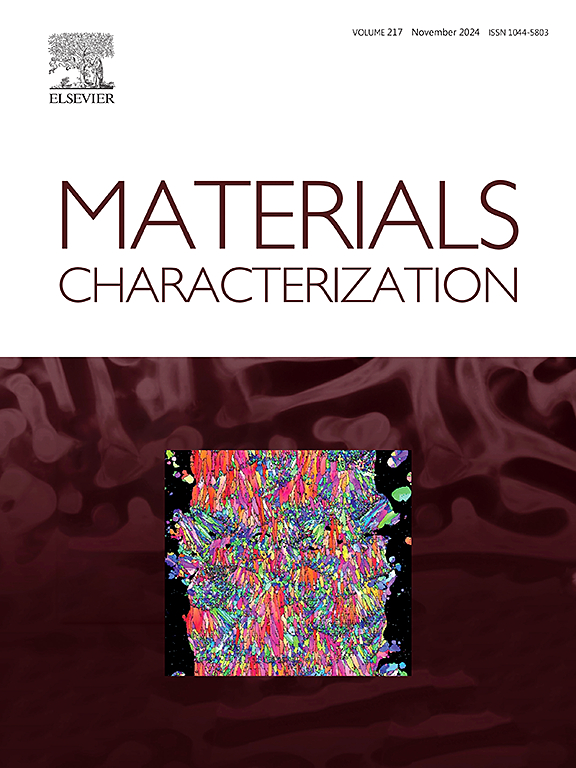Mo triggered TWIP/TRIP effect synergistically improves mechanical properties of Co35Cr25Fe20Ni20
IF 4.8
2区 材料科学
Q1 MATERIALS SCIENCE, CHARACTERIZATION & TESTING
引用次数: 0
Abstract
In this study, the strength-ductility paradox of high-entropy alloys was overcome by modulating the twin-induced plasticity (TWIP)/phase-transformation-induced plasticity (TRIP) effect through Mo atoms, while ensuring that it remains the single solid solution phase. With the increase of Mo atoms leads to a reduction in grain size, the reduction from 11.05 μm for Mo0 to 7.15 μm for Mo5 exhibits obvious grain refinement effect. Meanwhile, the addition of Mo improves the mechanical properties, from Mo0 yield strength of 326 MPa, tensile strength of 751 MPa, to Mo5 yield strength of 547 MPa, tensile strength of 998 MPa, maintains an elongation of 55 %. The formation of deformation twins (DTs) and hexagonal close-packed (hcp) phases improves not only the strength but also the work-hardening capacity. At the same time, these structures also ensured ductility with the help of TWIP and TRIP effects. Molecular dynamics simulations revealed that the formation of the hcp phase is associated with intrinsic stacking faults (ISFs) and DTs. The interlocking of ISFs and the appearance of DTs provide nucleation sites for the formation of hcp. Besides, the addition of Mo facilitates the charge redistribution of the matrix alloy, enhancing the overall Bader charge transfer. This explained that Mo can result in local lattice distortion, which is one of the important factors for the strength enhancement of Mo atoms. At the same time, this charge redistribution inevitably affects the chemical short-range ordered (CSRO) structure. The Warren-Cowley parameters confirmed that Mo increases Mo![]() Co, Mo
Co, Mo![]() Fe, and Mo
Fe, and Mo![]() Ni clusters, and more chemical short-range structures enhanced the stacking faults energy (SFE), it favours the generation of deformation twins.
Ni clusters, and more chemical short-range structures enhanced the stacking faults energy (SFE), it favours the generation of deformation twins.
Mo触发的TWIP/TRIP效应协同提高了Co35Cr25Fe20Ni20的力学性能
在本研究中,通过Mo原子调节双致塑性(TWIP)/相变致塑性(TRIP)效应,克服了高熵合金的强度-塑性悖论,同时确保其保持单一固溶相。随着Mo原子数的增加晶粒尺寸减小,Mo0从11.05 μm减小到7.15 μm,表现出明显的晶粒细化效应。同时,Mo的加入改善了材料的力学性能,从Mo0的屈服强度为326 MPa,抗拉强度为751 MPa,到Mo5的屈服强度为547 MPa,抗拉强度为998 MPa,伸长率保持在55%。变形孪晶(DTs)和六方致密相(hcp)的形成不仅提高了强度,而且提高了加工硬化能力。同时,这些结构还借助TWIP和TRIP效应保证了延性。分子动力学模拟表明,hcp相的形成与本征层错(ISFs)和DTs有关。isf的互锁和dt的出现为hcp的形成提供了成核位点。此外,Mo的加入有利于基体合金的电荷再分配,增强了整体的巴德电荷转移。这解释了Mo会导致局部晶格畸变,这是Mo原子强度增强的重要因素之一。同时,这种电荷重分配不可避免地影响了化学短程有序结构。Warren-Cowley参数证实Mo增加了MoCo、MoFe和MoNi簇,更多的化学短程结构增加了层错能(SFE),有利于变形孪晶的产生。
本文章由计算机程序翻译,如有差异,请以英文原文为准。
求助全文
约1分钟内获得全文
求助全文
来源期刊

Materials Characterization
工程技术-材料科学:表征与测试
CiteScore
7.60
自引率
8.50%
发文量
746
审稿时长
36 days
期刊介绍:
Materials Characterization features original articles and state-of-the-art reviews on theoretical and practical aspects of the structure and behaviour of materials.
The Journal focuses on all characterization techniques, including all forms of microscopy (light, electron, acoustic, etc.,) and analysis (especially microanalysis and surface analytical techniques). Developments in both this wide range of techniques and their application to the quantification of the microstructure of materials are essential facets of the Journal.
The Journal provides the Materials Scientist/Engineer with up-to-date information on many types of materials with an underlying theme of explaining the behavior of materials using novel approaches. Materials covered by the journal include:
Metals & Alloys
Ceramics
Nanomaterials
Biomedical materials
Optical materials
Composites
Natural Materials.
 求助内容:
求助内容: 应助结果提醒方式:
应助结果提醒方式:


